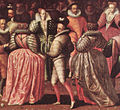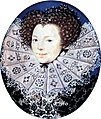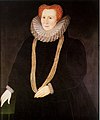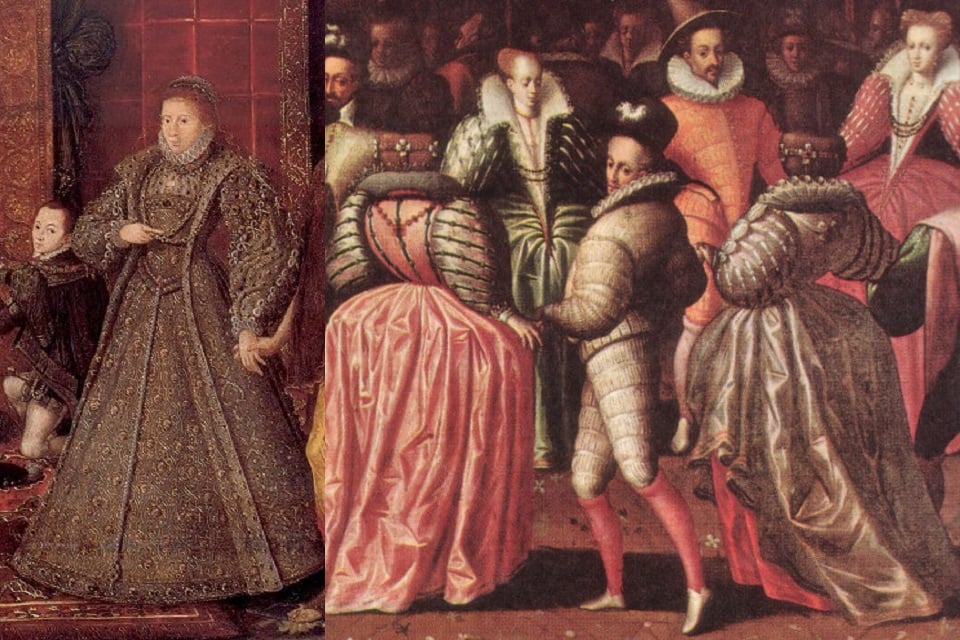Fashion in the period 1580–1600 in Western European clothing was characterized by increased opulence. The number of tradesmen and craftsmen specializing in the invention of clothing increased, and with the fall of the Byzantine Empire, Eastern Europe would take the lead in producing styles and trends applied to the production of clothing.
One of the main influences in European fashion in the sixteenth century was the Spanish court. One of the main trends on the part of the members of the court was the use of great collars in the neck, that was in use by approximately two centuries. Women of the nobility began to use high heels, dresses rounded and with glitter. The dresses became firmly tied to the bust. Men of lower classes wore plain and simple sweaters and tights, and women wore plain dresses.
On the other hand, the Puritans who lived in the United Kingdom , and who would have vital importance in the colonization of the United States , did not much care for styles and tendencies, preferring simple clothes. The women wore long, simple dresses.
Contrasting fabrics, slashes, embroidery, applied trims, and other forms of surface ornamentation remained prominent. The wide silhouette, conical for women with breadth at the hips and broadly square for men with width at the shoulders had reached its peak in the 1530s, and by mid-century a tall, narrow line with a V-shaped waist was back in fashion. Sleeves and women’s skirts then began to widen again, with emphasis at the shoulder that would continue into the next century. The characteristic garment of the period was the ruff, which began as a modest ruffle attached to the neckband of a shirt or smock and grew into a separate garment of fine linen, trimmed with lace, cutwork or embroidery, and shaped into crisp, precise folds with starch and heated irons.
Women’s fashion
Women’s outer clothing generally consisted of a loose or fitted gown worn over a kirtle or petticoat (or both). An alternative to the gown was a short jacket or a doublet cut with a high neckline. By the 1580s these had been adapted in England as padded and jeweled shoulder rolls.
In the late 16th century, the extremely high waistline returns to its natural position. The skirt became the floor length, it became round and took plenty of folds widely. Like a man, the underwear collar gets clogged high and embroidered.
Women’s dress put on a canvas or a hinged iron corset with a reed with a reed on top of a chemi-packed chemise. Women put a jup ( petticoat ) on top of it and layered a low gown of neckline on top.
In the late 16th century a dress called French style gown is popular. In preparation for underwear, Women’s shirt of a round collar, Women wore a shoes and tightened a corset tailored with a whale bone called call • pique. The thin hips were popularized, Catherine de Medicis of the time was a 40 centimeter, Mary Stuart was a narrow stance of 37 centimeters. In addition, wearing a pad similar to the floating ring called Ausukyu on the front descending (adding Furin Gale also in the UK). And one or two Jupu (petticoat) wearing a blouse with a sleeveless neckline wearing a low gown. Women put a sleeve separately on the gown, but Women wrapped a phrase around their neck with an epaulet covered on the sleeve.
Common people
The one that matches the underskirt to the cot from the medieval times and the one where the skirt and the apron are matched to the short jacket of the jacket which is the prototype of the jacket, the figure of the farm village wearing things like a bodys prints etc. . Compared to men, clothes look relatively modern, but unlike skirts with large spread of ladies and floor girls, the length is shorter than the ankle. They cover their hair with a hood covering the heads and a scarf.
A citizen’s woman gathered a crown in a chemises which made fine embroidery on the collar part with a stuffed collar. Early in the 16th century, clothes such as an apron and a hood are often seen in a slender long-sleeved dress style costume. Some also see examples wearing a bodice, and a figure with a large collarbone that covers the shoulder Koller and hangs to her chest.
Upstream citizen
Upstream citizen’s women’s clothing is almost the same as that of a lady. Women wore a robe whose skirt was bulging, in the summer women wore a somewhat simpler thing called Marlot, Berne (there is no big difference from robes). Things like apron called Taburie became popular, and it fell down in front of the skirt. Although it was a front dirt repellent, it had been subjected to embroidery and tailored with damask woven, and the decorative meaning was strong.
In the middle of the 16th century Spain introduced a phrase collar, a corset and a skelt for extending the skirt of Velucutadan. The sleeves were tailored separately, the robes were different from the robes as well as the coffer, and the sleeves of different materials were sewn afterwards and the seams were covered with Epaulette. At the end of the 16th century the upper and lower part of the waist became independent as a bodys and skirt, and the chest opened. French diplomat De Messaz wrote that Elizabeth I has a dress that has opened up to the navel. In order to hide the corset which became visible with the opening of the chest, we tried to attach a triangular chest pocket decorated as Pies-Destma from the inside of the robe with a hook. The top skirt was attached by hook etc. along the sag of the hem of the bodice.
At the beginning of the corset the royal lady brought something like an iron armor. It was shaped like an inverted triangle worn with a hinge, and had a watermark carved. More widely used was a thick linen like a canvas with a few stitches backed from the back, made into a core through the stem of the reed, called quilling meaning Call / Piquet. It was more expensive to put braided whale bowls while brewing whale bones with fire, tightened with strings and worn.
Velucuganin was like a special petticoat for spreading the skirt in a bell shape, wearing a rattan wheel sewn into a sturdy cotton or woolen cloth in order of small to large. In France, it is a pad like a float of the aus cube, in the UK a drum-shaped Velucu-gudan using a branch called Feel • Fasin Gale is wrapped around the waist, the style where the skirt spreads sideways from the waist to the floor It became fashionable. Under the petticoat women wore something like Carson’s pants. Although it is often found in the account book and the property list, the table does not often appear as a table, but it is recorded that Catherine • Medicis owned Carson tailored with black taffeta. Carson made of Italian made linen is left as a lady of the ladies of the time, which is regarded as a prototype of the drawer .
In the book “dialogue on beauty of women” autographed by Italian monks in 1548, there is a detailed account of Renaissance ideal beautiful woman. First of all, it is fair. Secondly it is mentioned that it is rich blond hair. It is said that “golden color, honey color, sun color” is good here, so it seems that a bright, clear color blonde was popular. The forehead is widely high, the eyebrows are gently curved upwards, the shape with the eyebrows falling, the rounded big eyes with chestnuts, the nasal heads somewhat upward with a thin nasal bridge, small mouth, long slender neck, slightly The rich jaw was a testimony of a beautiful woman.
Although there was white lead white as a cosmetic product, it seems that the satire poetry is painting the skin with “Venice ‘s white wool ” etc, so it may have been used properly depending on the economic situation and part. The state in which blusher is preferred is to draw a vein in Elizabethan novel “Anneka”, show the eyes vividly, dye the hair, smoothen the skin, dye the cheek red, inflate the chest, make the teeth pure white It is understood also from the appearance of guru.
In Elizabeth morning , the hair was popular as it is expressed as “burning hair” rather than the golden color of Florenzora, honey color, sun color. This is influenced that Elizabeth I was pretty red-colored blond hair and was proud of that hair. A Scottish diplomat writes to his country that Queen Elizabeth has changed his gorgeous costume everyday, asking Mary Queen of Scotland who is beautiful or himself, and praising his hair.
Initially, a hard headband called Bone Chaplon or Bonnet de Vauve suffered a hood suppression hood. It was smaller than medieval ones, and then hair appeared. When it became common to reveal hair, she liked to wear billetta and talk hat (small cylindrical hat) that decorated feathers and jewels like men. There are also differences between Italian style, French style and German style, and Lovey wrote that French women used different gifts for each season.
Shoes were almost the same as those of men, and they gradually changed from cheek lip to Oxford type.
Upper class
François I has a hobby to present luxurious fabrics to women, and gave a garland fabric woven gold thread in his niece Marguerite to make a robe decorating silver flowers. As a result, the eleven-year-old princess said that he could not move, but a noble woman like her was obviously to decorate more precious metals and jewelry (mostly pearls) on luxurious fabrics. Austrian Grand Duke Catarina knows from the inventory that he had robes decorating 28 pearls. Queen Elizabeth possessed black velvet mourning decorated “like a queen” with pearls and silver threads.
Style gallery 1570s
 1 – 1570 |
 2 – 1571 |
 3 – 1571 |
 4 – 1571 |
 5 – 1572 |
|---|---|---|---|---|
 6 – c. 1575 |
 7 – 1578 |
 8 – 1578 |
 9 – 1579 |
1.Horizontal lacing over a stomacher and an open chemise are characteristic of Venetian fashion. The skirt is gathered at the waist.
2.Consort of Spain, Anna of Austria by Alonso Sánchez Coello wearing Spanish fashion, 1571.
3.Leonora di Toledo of Florence, Italy wears a blue gown with a flared collar and tight undersleeves with horizontal trim. The uncorseted S-shaped figure is clearly shown, 1571.
4.Elizabeth of Austria is portrayed by the French court painter François Clouet in a brocade gown and a partlet with a lattice of jewels, 1571. The lattice partlet is a common French fashion.
5.In this allegorical painting c. 1572, Elizabeth I wears a fitted gown with hanging sleeves over a matching arched bodice and skirt or petticoat, elaborate undersleeves, and a high-necked chemise with a ruff. Her skirt fits smoothly over a Spanish farthingale.
6.Elizabeth I wears a doublet with fringed braid trim that forms button loops and a matching petticoat. Janet Arnold suggests that this method of trimming may be a Polish fashion (similar trimmings à la hussar were worn in the 19th century).
7.Mary, Queen of Scots in captivity wears French fashions: her open ruff fastens at the base of the neck, and her skirt hangs in soft folds over a French farthingale. She wears a cap and veil.
8.Nicholas Hilliard’s miniature of his wife Alice shows her wearing an open partlet and a closed ruff. Her blackwork sleeves have a sheer overlayer. She wears a black hood with a veil, 1578.
9.German fashion: Margarethe Elisabeth von Ansbach-Bayreuth wears a tall-collared black gown over a reddish-pink doublet with tight sleeves and a matching petticoat. She wears a black hat.
Style gallery 1580s
 1 – 1580s |
 2 – 1580s |
 3 – 1580s |
 4 – 1582 |
 5 – 1584 |
|---|---|---|---|---|
 6 – 1585–90 |
 7 – 1585–90 |
 8 – 1585 |
 9 – 1589 |
1.Lettice Knollys wears an embroidered black high-necked bodice with round sleeves and skirt over a gold petticoat or forepart and matching undersleeves, a lace cartwheel ruff and lace cuffs, and a tall black hat with a jeweled ostrich feather, c. 1580s.
2.Elizabeth I wears a black gown with vertical bands of trim on the bodice. The curved waistline and dropped front opening of the overskirt suggest that she is wearing a French roll to support her skirt. She wears a heart-shaped cap and a sheer veil decorated with a pattern of pearls, early 1580s.
3.Ladies of the French court c. 1580 wear gowns with wide French farthingales, long pointed bodices with revers and open ruffs, and full sleeves. This style appears in England around 1590. Note the fashionable sway-backed posture that goes with the long bodice resting on the farthingale.
4.Anne Knollys wears a black gown and full white sleeves trimmed with gold lace or braid. She wears a French hood with a jewelled billiment and a black veil, 1582.
5.The Infanta Isabella Clara Eugenia of Spain is seen here again wearing a Spanish farthingale, a closed overskirt, and the typically Spanish, long, pointed oversleeves. She is wearing black, a testament to the austere side of the Spanish court, c. 1584.
6.Nicholas Hilliard’s Unknown Woman wears a cutwork cartwheel ruff. Her stomacher and wired heart-shaped coif are both decorated with blackwork embroidery, 1585–90.
7.Elizabeth I wears a cartwheel ruff slightly open at the front, supported by a supportasse. Her blackwork sleeves have sheer linen oversleeves, and she wears wired veil with bads of gold lace, 1585–90.
8.Infanta Catalina Micaela of Spain wears an entirely black gown with lace collar and cuffs, with white inner sleeves trimmed with gold embroidery or applied braid. Her jewellery includes a double string of pearls, a necklace, worked golden buttons and a belt.
9.Elizabeth Brydges, aged 14, wears a black brocade gown over a French farthingale. The blackwork embroidery on her smock is visible above the arch of her bodice; her cuffs are also trimmed with blackwork. This style is uniquely English. She wears an open-fronted cartwheel ruff.
Style gallery 1590s
 1 – 1592 |
 2 – 1592 |
 3 – 1592 |
 4 – c. 1592 |
 5 – 1593–95 |
|---|---|---|---|---|
 6 – 1594 |
 7 – 1590 |
 8 – 1595 |
1.The widowed Bess of Hardwick, Countess of Shrewsbury, wears a black gown and cap with a linen ruff, 1590.
2.Elizabeth I, 1592, wears a dark red gown (the fabric is just visible at the waist under her arms) with hanging sleeves lined in white satin to match her bodice, undersleeves, and petticoat, which is pinned to a cartwheel farthingale. She carries leather gloves and an early folding fan.
3.Elizabeth I wears a painted petticoat with her black gown and cartwheel farthingale. She wears an open lace ruff and a sheer, wired veil frames her head and shoulders. Her skirt is ankle-length and shows her shoes, 1592.
4.English woman wears a fashion seen in many formal portraits of Puritan women in the 1590s, characterized by a black gown worn with a blackwork stomacher and a small French farthingale or half-roll, with a fine linen ruff and moderate use of lace and other trim. She wears a tall black hat called a capotain over a sheer linen cap and simple jewelry.
5.Italian style: Maria de Medici wears a bodice with split, round hanging sleeves. Her tight undersleeves are chartacteristic of Spanish influence. From the folds of her skirt, she appears to be wearing a small roll over a narrow Spanish farthingale. Note that her oversleeves are the same shape as those worn by Lettice Knollys.
6.This portrait (assumed to be Maria de Medici) shows the adaptation of fashion to accommodate pregnancy. A loose dark gown is worn over a matching bodice and skirt, with tight white undersleeves. The lady wears an open figure-of-eight ruff of reticella lace, 1594.
7.Italian fashion of the 1590s featured bodices cut below the breasts and terminating in a blunt U-shape at the front waist, worn over open high-necked chemises with ruffled collars that frame the head. The Dogaressa of Venice wears a cloth of gold gown and matching cape and a sheer veil over a small cap, 1590s.
8.Unknown English lady, formerly called Elizabeth I, wears a black gown over a white bodice and sleeves embroidered in black and gold, and a spotted white petticoat. Her hood is draped over her forehead in a style called a bongrace, and she carries a zibellino or flea-fur, with a jeweled face, 1595.
Source from Wikipedia
